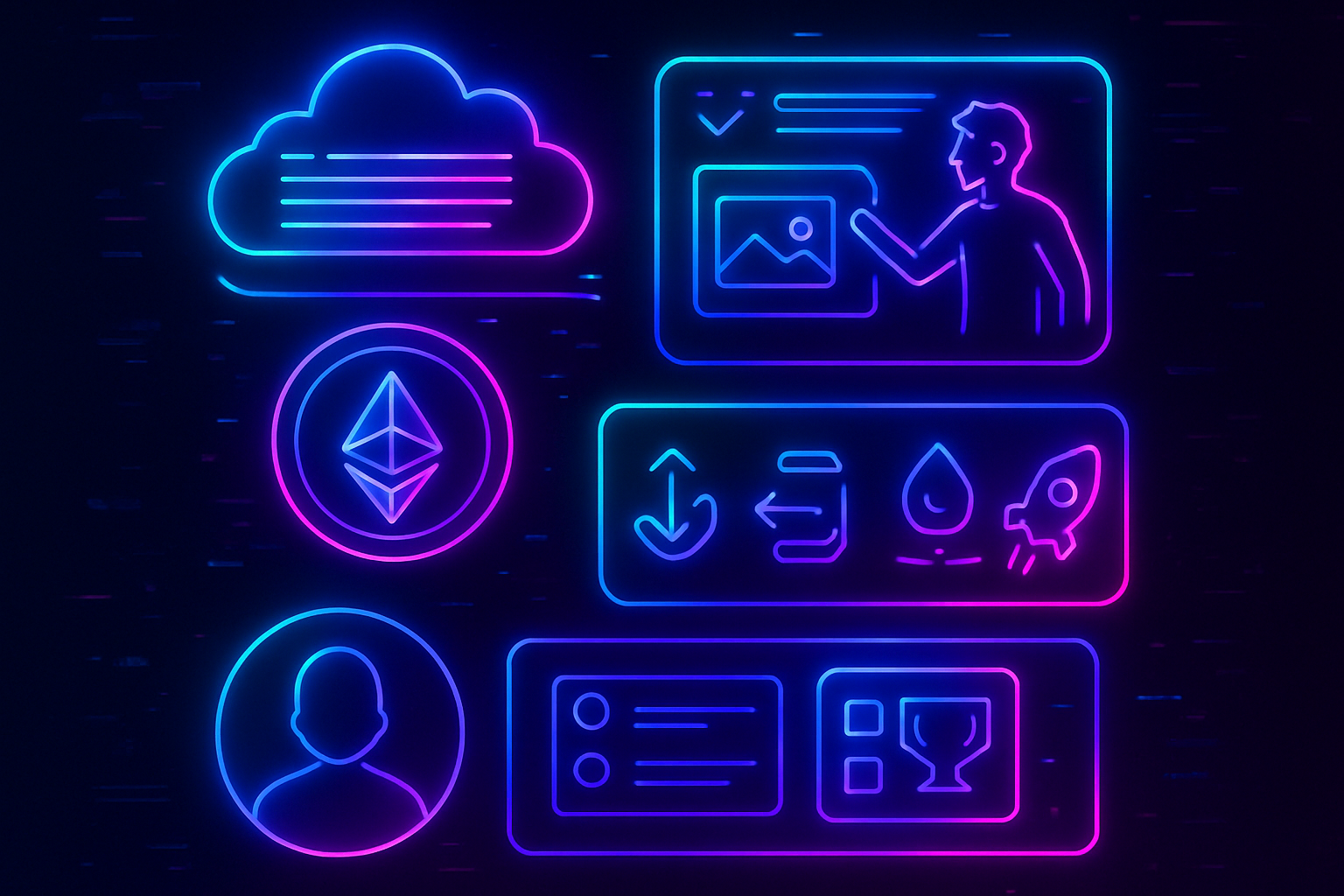
As SocialFi matures, the Base blockchain has emerged as a pivotal hub for decentralized social networks. By blending social media with DeFi mechanics, Base SocialFi platforms empower users to monetize engagement, own their data, and participate in governance. In this comparative analysis, we focus on the three most influential Base SocialFi projects of 2025: Farcaster (Warpcast), Friend. tech, and Alpha (alpha. app). Each brings a unique vision for the future of online interaction and value creation.
Exploring the Leaders: Farcaster (Warpcast), Friend. tech, and Alpha
The competitive landscape of Base SocialFi is defined by rapid innovation and shifting user preferences. Let’s break down how these platforms stack up in terms of core features, fee structures, and overall user experience.
Comparison of Top Base SocialFi Platforms (2025)
| Platform | Logo | Core Features | Fee Structure | User Experience Rating |
|---|---|---|---|---|
| Farcaster (Warpcast) | 🌐 | Decentralized social protocol; composable profiles; open API for developers; strong focus on user data ownership. | Minimal transaction fees (leverages Base’s low-cost infrastructure); no direct platform fees for basic use. | ⭐⭐⭐⭐☆ (Highly praised for openness and developer activity; growing user base, but still maturing) |
| Friend.tech | 🔑 | Tokenized access via “keys”; exclusive chat rooms; creator monetization; built on Base for fast, low-cost transactions. | 1% transaction fee on trades within the platform. | ⭐⭐⭐☆☆ (Initial explosive growth, but user engagement declined after peak activity) |
| Alpha (alpha.app) | 🅰️ | Decentralized social network; focus on privacy and user rewards; integrated tipping and content monetization. | Low transaction fees (Base network); tipping fees may apply depending on activity. | ⭐⭐⭐⭐☆ (Positive feedback for privacy and rewards, active community, but smaller user base than competitors) |
Farcaster (Warpcast): Protocol-First Decentralized Social Networking
Farcaster, accessed primarily via its flagship client Warpcast, is lauded for its protocol-first approach to decentralized social networking. Unlike walled-garden platforms, Farcaster enables users to truly own their profiles, posts, and social graphs. The platform’s open architecture encourages third-party developers to build new apps atop its protocol, fostering a vibrant ecosystem around user-owned data.
- User Ownership: Profiles are portable across any app built on Farcaster. This creates true digital sovereignty.
- Composable Identity: Users can link wallets, ENS names, or social handles as part of their on-chain identity.
- Ecosystem Growth: The DEGEN token and tipping culture have catalyzed organic community growth within Warpcast channels.
Fees: Farcaster charges minimal fees for registration (typically under $5 in BASE), with negligible costs for posting or interacting due to Base’s low transaction fees.
User Experience: Warpcast’s clean interface rivals Web2 apps in usability. However, onboarding still requires some crypto literacy. Power users praise the composability but casual users may find the protocol-centric model initially complex.
Friend. tech: Tokenizing Influence and Creator Engagement
Friend. tech pioneered the “tokenized access” model on Base by allowing creators to issue “keys” that grant exclusive chatroom access. This mechanism directly monetizes social influence – fans buy keys to interact more closely with thought leaders or celebrities.
- Key Trading: Keys function as ERC-20 tokens tradable within Friend. tech’s in-app marketplace.
- Sustainable Monetization: Creators earn a percentage from every key trade involving their profile.
- Simplicity: The app abstracts away much of the blockchain complexity for end-users; sign-up is possible via X/Twitter credentials linked to an Ethereum wallet.
Fees: Friend. tech charges a flat 1% fee per transaction within its ecosystem – both when buying and selling keys. Additional gas fees are minimal due to Base’s efficiency.
User Experience: Friend. tech saw explosive growth at launch but faced challenges retaining long-term engagement as speculative trading cooled off. Still, it remains popular among creators seeking direct monetization channels without intermediaries.
Base (BASE) Price Prediction 2026-2031
Forecast based on current SocialFi trends, market conditions, and technical analysis as of Q4 2025
| Year | Minimum Price (Bearish) | Average Price | Maximum Price (Bullish) | Year-over-Year % Change (Avg) | Market Sentiment Scenario |
|---|---|---|---|---|---|
| 2026 | $0.38 | $0.54 | $0.88 | +20% | Recovery and early SocialFi adoption |
| 2027 | $0.50 | $0.68 | $1.10 | +26% | Mainstream adoption, new SocialFi innovations |
| 2028 | $0.62 | $0.82 | $1.35 | +21% | Strong competition, regulatory clarity |
| 2029 | $0.58 | $0.91 | $1.52 | +11% | Market consolidation, improved utilities |
| 2030 | $0.50 | $1.04 | $1.85 | +14% | Technological breakthroughs, new user growth |
| 2031 | $0.45 | $1.12 | $2.10 | +8% | Mature SocialFi market, stable growth |
Price Prediction Summary
BASE is expected to see steady growth from 2026 to 2031, driven by the continued evolution of SocialFi platforms, increased user adoption, and ongoing technological improvements in the Base ecosystem. Price volatility is anticipated due to market cycles, competition, and the broader regulatory environment. The average price could more than double by 2031 from current levels, with maximum bullish scenarios reflecting major SocialFi breakthroughs or mass adoption.
Key Factors Affecting Base Price
- SocialFi sector adoption rates and user retention on Base-powered platforms
- Technological advancements and scalability improvements on Base
- Integration with major DeFi and Web3 applications
- Competition from alternative SocialFi blockchains (e.g., Polygon, Aptos)
- Regulatory policy changes impacting social tokens and decentralized identity
- Macro crypto market cycles and investor sentiment
- Partnerships and ecosystem development within Coinbase and the broader Base community
Disclaimer: Cryptocurrency price predictions are speculative and based on current market analysis.
Actual prices may vary significantly due to market volatility, regulatory changes, and other factors.
Always do your own research before making investment decisions.
Alpha (alpha. app): Gamified Community Building on Base
The newest entrant among top-tier Base SocialFi apps is Alpha (alpha. app). Alpha distinguishes itself through gamified quests and community-driven incentives designed to maximize user participation while rewarding positive contributions with points or tokens.
- Missions and Quests: Users complete tasks such as content curation or referral campaigns to earn rewards.
- Loyalty Tiers: Active members unlock higher tiers granting access to premium features or governance rights within Alpha communities.
- No-Code Tools: Community leaders can launch custom quests without technical expertise – lowering barriers for grassroots organizing.
Fees: Alpha operates on a freemium model; basic usage is free while advanced features may require staking or microtransactions in BASE tokens. Transaction fees remain low thanks to the underlying network efficiency – at present BASE trades at exactly $0.4485 per token (as of September 19th, 2025).
User Experience: Early feedback highlights Alpha’s engaging UX reminiscent of popular Web3 quest platforms but tailored specifically for social interaction rather than DeFi farming alone. The learning curve is gentle enough for mainstream adoption yet robust enough for power users seeking deeper involvement in DAO-style governance or creator economies.
When evaluating the user experience across these three Base SocialFi platforms, it becomes clear that each targets a distinct demographic and engagement style. Farcaster (Warpcast) appeals to crypto-native users who value digital sovereignty and composability, while Friend. tech is optimized for creators and influencers seeking straightforward monetization. Alpha (alpha. app), meanwhile, focuses on gamification and community engagement, lowering onboarding barriers for newcomers to Web3 social networks.
Comparative Analysis: Features, Fees, and User Experience
Comparison of Top Base SocialFi Platforms: Features, Fees, and User Experience (2025)
| Platform | Key Features | Fee Structure | User Experience |
|---|---|---|---|
| Farcaster (Warpcast) | Decentralized social network; user-owned identity; open protocol for developers; strong focus on interoperability | Minimal transaction fees (leverages Base for low costs); most core features are free to use | Highly active developer and user community; praised for open ecosystem and extensibility; user-friendly interface |
| Friend.tech | Tokenized access to exclusive chat rooms; creator monetization via trading fees; built on Base for low fees and fast transactions | 1% fee on all in-app transactions | Rapid initial adoption but saw a decline in user engagement and revenue by late 2024; simple onboarding and monetization for creators |
| Alpha (alpha.app) | Community-centric platform; integrates social feeds with DeFi tools; supports tokenized interactions and rewards | Low transaction fees (Base network); potential small platform fee on certain features | Emerging user base; positive feedback for combining social and DeFi; intuitive design but still building broader engagement |
Security is another critical dimension. All three platforms leverage the Base blockchain’s low-fee environment for scalable transactions. However, Farcaster’s open protocol model means user data is less dependent on any single application or company, an advantage for those concerned about platform risk or censorship resistance. Friend. tech’s reliance on key trading introduces speculative elements but also exposes users to market volatility; effective risk management is essential for both creators and participants. Alpha’s mission-based incentives are designed to foster organic growth rather than speculation, though as with any gamified system, sustaining long-term engagement will depend on continuous innovation.
From a fees perspective, all three platforms benefit from Base’s cost efficiency, transaction costs remain negligible compared to legacy blockchains. Friend. tech’s 1% transaction fee is transparent and easy to calculate; Farcaster charges minimal registration costs with near-zero posting fees; Alpha employs a hybrid model where core functionality is free but premium features may require staking BASE tokens (currently priced at $0.4485). For active users or communities managing large volumes of interactions, these differences can add up over time.

Community dynamics also diverge sharply:
- Farcaster: Community-driven channels thrive around niche interests, especially crypto culture, supported by tipping via DEGEN tokens.
- Friend. tech: Social capital is highly liquid; communities form around high-profile personalities rather than shared interests.
- Alpha: Gamification encourages grassroots organizing; loyalty tiers reward sustained participation over speculation.
The pace of iteration in the Base SocialFi ecosystem means that today’s leaders must continue adapting. For example, Warpcast has recently rolled out enhanced moderation tools and third-party app integrations in response to community feedback. Friend. tech has experimented with new creator analytics dashboards to boost retention. Alpha regularly updates its quest mechanics based on DAO proposals from active users, a testament to the participatory ethos driving this sector forward.
Key Takeaways: Choosing the Right Base SocialFi Platform
Your ideal platform will depend on your goals as a user:
Pros and Cons: Farcaster (Warpcast), Friend.tech, and Alpha
-

Farcaster (Warpcast)Pros: Decentralized and open protocol enabling user ownership of social identity and data.Active developer ecosystem fosters innovation and third-party app integrations.Growing community with a reputation for high-quality discussions and content.Cons: Onboarding process can be complex for non-technical users.Limited mainstream adoption compared to traditional social platforms.Early-stage monetization features; fewer direct earning opportunities for creators than some competitors.
-

Friend.techPros: Tokenized access allows creators to monetize social influence through the sale of “keys” for exclusive chats.Simple user interface and seamless onboarding via Twitter/X accounts.Low transaction fees due to Base blockchain integration.Cons: User engagement decline observed after initial surge; revenue and activity have dropped significantly since launch.1% transaction fee on all trades can eat into creator and user earnings.Limited community features compared to more open or modular platforms.
-

Alpha (alpha.app)Pros: Focus on curated content and high-signal discussions for crypto and Web3 enthusiasts.Integrated analytics and discovery tools for trending topics and influential users.Base blockchain benefits such as low fees and fast transaction speeds.Cons: Smaller user base compared to Farcaster and Friend.tech, which may limit network effects.Still evolving; some features and monetization tools are in early development stages.Less mainstream recognition outside of crypto-native circles.
If you’re seeking composability and true data ownership in a decentralized social graph, Farcaster (Warpcast) stands out. For direct creator monetization with minimal friction, Friend. tech remains compelling, especially if you’re already established as an influencer or content producer. If gamified engagement and community rewards are your priority, Alpha (alpha. app) offers an accessible entry point into the world of decentralized social networking on Base at a low cost per transaction (BASE at $0.4485 as of September 19th 2025).
The SocialFi space on Base continues to evolve rapidly, expect further innovation as these platforms respond to shifting user demands and broader macro trends in crypto adoption. As always, approach new projects with diligence: evaluate tokenomics sustainability, community governance structures, and your own risk tolerance before diving in.



